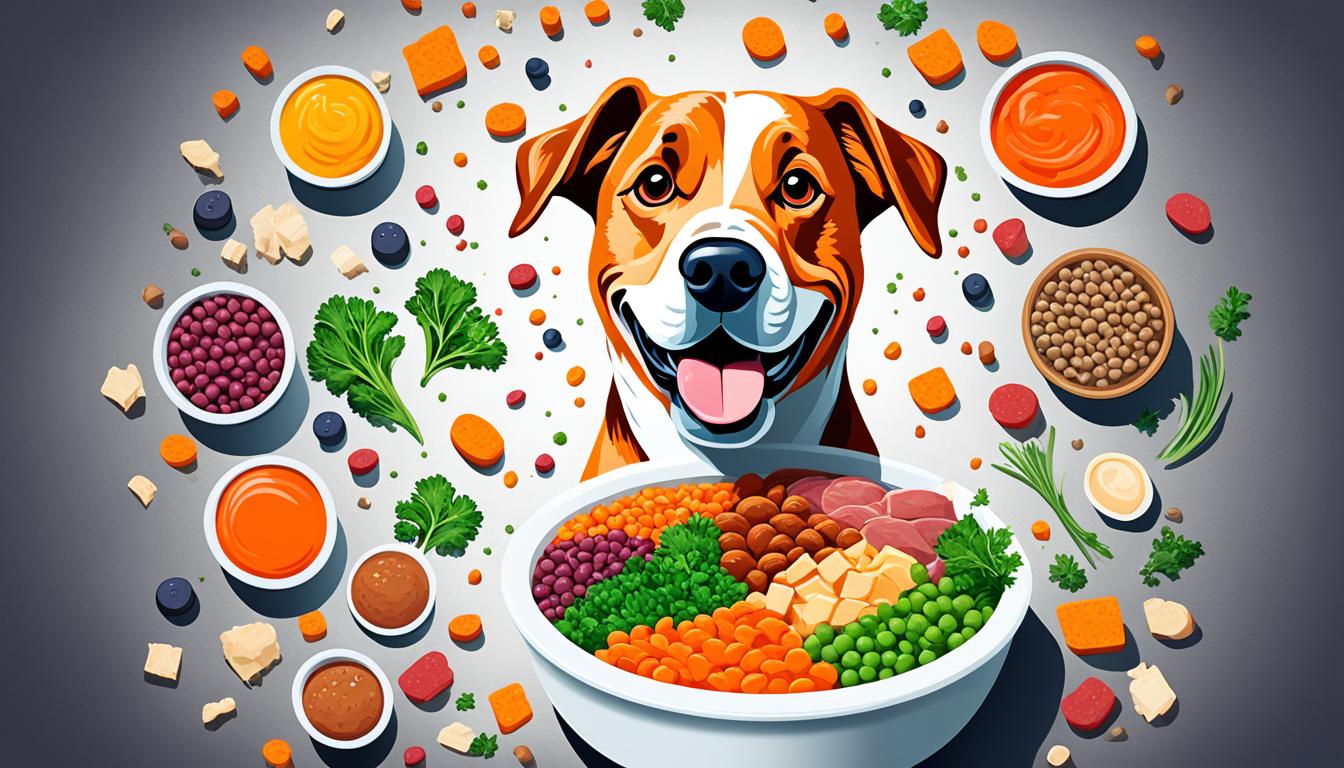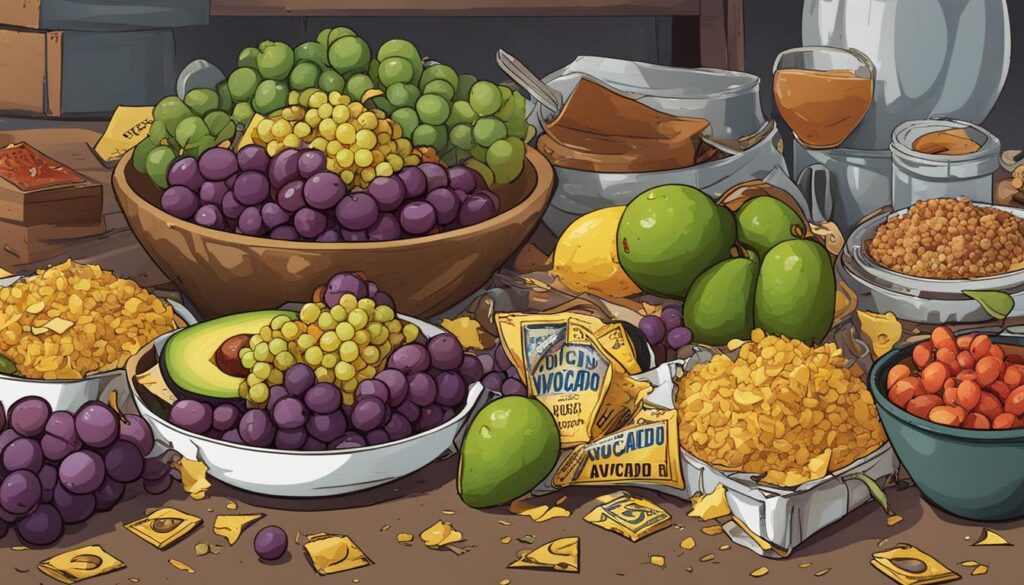Canine Cuisine: Cooking for Your Dog

Did you know that a balanced homemade diet can significantly improve your pet’s health and well-being? Cooking nutritious meals for your dog not only ensures they receive the essential nourishment they need, but it can also strengthen the bond between you and your furry friend. Discover the benefits of homemade dog food and explore delicious recipes that will make your pup’s tail wag with delight!
Key Takeaways:
- Homemade dog food provides numerous health benefits for your pet’s well-being.
- You have more control over the ingredients, ensuring a balanced and nutritious diet.
- Homemade food is particularly beneficial for dogs with picky eating habits or food intolerance issues.
- Avoid common mistakes, such as using unsafe ingredients or unbalanced recipes.
- Ensure a smooth transition and monitor your dog’s health when switching to homemade food.
The Benefits of Homemade Dog Food
Homemade dog food offers several advantages over commercial dog food. While there is no scientific evidence to support the claim that homemade food is superior, preparing meals for your dog allows you to have more control over its diet. It can be particularly beneficial for dogs with picky eating habits, food intolerance issues, or concern over food recalls. Moreover, cooking for your dog can strengthen the bond between you and your pet as you share the joy of preparing a home-cooked meal.
One of the key health benefits of homemade dog food is the ability to choose fresh, high-quality ingredients. By using nutritious recipes, you can ensure that your dog receives a balanced diet packed with essential nutrients. Unlike commercial dog food that may contain fillers or additives, homemade meals can be tailored to your dog’s specific dietary needs, promoting optimal health and well-being.
“Preparing meals for your dog allows you to have more control over its diet.”
Furthermore, homemade dog food allows you to customize the meals based on your dog’s preferences and any potential sensitivities. For dogs with allergies or intolerances, carefully selecting ingredients and creating homemade recipes can help alleviate symptoms and improve their overall health. Additionally, for pet owners who are concerned about the safety of commercial dog food due to recalls, preparing homemade meals offers peace of mind.
Strengthening the bond with your pet
Preparing homemade meals for your dog can also have a positive impact on the bond between you and your pet. Cooking for your dog allows you to actively participate in its well-being, demonstrating love and care through nutritious and delicious meals. The process of preparing and serving home-cooked food can create a sense of shared joy and satisfaction, strengthening the emotional connection between you and your furry companion.
The benefits of homemade dog food go beyond the physical health of your pet. By feeding your dog nutritious recipes and a balanced diet, you are contributing to its overall happiness and well-being. The quality time spent in the kitchen, the joy of meal preparation, and the knowledge that you are providing the best possible nutrition can bring immense satisfaction and fulfillment to both you and your dog.
Common Mistakes when Cooking for Your Dog
When it comes to cooking for your dog, there are some common mistakes that you should avoid to ensure your pet’s health and well-being. Understanding these mistakes and taking steps to prevent them will help you provide safe and nutritious meals for your furry companion.
Using Unsafe Ingredients
- Chocolate: While chocolate is a sweet treat for humans, it contains theobromine, which is toxic to dogs and can cause symptoms like vomiting, diarrhea, and even seizures.
- Garlic and Onions: These ingredients, whether raw, cooked, or powdered, contain compounds that can damage your dog’s red blood cells and lead to anemia.
- Grapes: Grapes and raisins can cause kidney failure in dogs, so it’s important to avoid giving them as treats or including them in meals.
By being aware of these unsafe ingredients, you can protect your dog from potential harm and ensure that every meal you prepare is safe and enjoyable. Consult a veterinary nutritionist or trusted sources for a comprehensive list of ingredients to avoid.
Preparing Unbalanced Meals
Another common mistake when cooking for your dog is not preparing balanced meals tailored to their specific nutritional needs. Dogs require a balanced diet that includes proteins, carbohydrates, fats, vitamins, and minerals.
“A well-balanced meal is essential for your dog’s overall health and vitality. It helps support their immune system, maintain healthy weight, and promotes optimal organ function.” – Dr. Sarah Peterson, Veterinary Nutritionist
When designing your dog’s meals, consider their age, size, activity level, and any specific dietary requirements they may have. Aim for a variety of protein options, such as lean meats and fish, along with appropriate servings of vegetables and carbohydrates.
Inadequate Recipes
Relying on inadequate recipes can undermine the nutritional value of the food you prepare for your dog. It may seem convenient to use multiple recipes for variety, but it’s important to ensure that each recipe addresses your dog’s specific nutritional needs.
Consult with veterinary nutritionists or trusted sources for well-rounded recipes that meet your dog’s dietary requirements. They can provide guidance on portion sizes and ingredient combinations to ensure your dog receives the necessary nutrients for their overall health.
| Common Mistakes | Impact on Your Dog’s Health |
|---|---|
| Using unsafe ingredients | Can lead to toxicity, organ damage, and other serious health issues |
| Preparing unbalanced meals | May result in nutritional deficiencies or excesses, affecting your dog’s overall well-being |
| Inadequate recipes | Can undermine the nutritional value of the food, potentially leading to health problems in the long run |
By avoiding these common mistakes and prioritizing your dog’s nutritional needs, you can confidently prepare homemade meals that contribute to their overall health and happiness.

Healthy Ingredients for Homemade Dog Food
When preparing homemade dog food, it’s crucial to include a variety of healthy ingredients to ensure your furry friend gets the balanced nutrition they need. Here are some excellent options for proteins, vegetables, and carbohydrates to incorporate into your dog’s meals:
Protein Options
- Beef: A lean source of protein that provides essential amino acids.
- Turkey: A low-fat option that is easy to digest.
- Chicken: Rich in protein and low in fat, ideal for dogs with sensitive stomachs.
- Fish: Packed with omega-3 fatty acids that promote a healthy coat and skin.
Vegetable Choices
- Carrots: A crunchy and nutritious vegetable that offers vitamins A and K.
- Green beans: A great source of fiber and vitamins C and K.
- Spinach: Contains iron, calcium, and a range of vitamins and minerals.
- Peas: Packed with antioxidants, fiber, and vitamins A, C, and K.
Carbohydrate Sources
- Rice: Easily digestible and a good source of energy.
- Potatoes: Provide carbohydrates and are packed with essential nutrients.
- Pasta: Offers energy and can be a tasty addition to your dog’s meals.
Note: It’s important to avoid certain ingredients when preparing homemade dog food. Stay away from alcohol, avocados, chocolate, and grapes as they can be toxic to dogs. Always prioritize your pet’s safety and wellbeing.
Additionally, incorporating sources of calcium, such as cottage cheese or plain yogurt, can help support your dog’s bone health. Remember to consult with your veterinarian to determine the appropriate portion sizes and to ensure that the chosen ingredients meet your dog’s specific dietary needs.
By including a variety of protein options, vegetable choices, and carbohydrate sources in your homemade dog food recipes, you can provide your furry companion with a well-rounded and nutritious diet.
Making the Switch to Homemade Dog Food
Transitioning your dog to a homemade food diet requires careful planning and consideration. It’s important to make the switch gradually over a period of 6 days to a week to ensure a smooth transition.
Begin by mixing a small portion of the new homemade food with your dog’s current diet. This allows your dog to become familiar with the new flavors and textures while still receiving nutrition from its regular food. Gradually increase the proportion of the new food each day until it becomes the primary component of your dog’s diet.
While transitioning, it’s crucial to monitor your dog’s health closely. Keep an eye out for any digestive issues or changes in appetite. Some dogs may experience mild stomach upset during the transition phase, but if symptoms persist or worsen, consult your veterinarian for guidance.
Portion control is another important aspect to consider when switching to homemade dog food. It’s essential to provide the right amount of food based on your dog’s size, age, and activity level. Overfeeding can lead to weight gain and other health issues, while underfeeding can result in nutrient deficiencies.
To ensure you’re providing the appropriate portion sizes, regularly weigh your dog and consult with your veterinarian. They can help determine the ideal weight for your dog and provide guidance on adjusting the portion sizes if necessary.

Tips for Transitioning to Homemade Dog Food:
- Gradually introduce homemade food over a period of 6 days to a week.
- Mix a small portion of the new food with your dog’s current diet to ease the transition.
- Monitor your dog’s health for any digestive issues or changes in appetite.
- Ensure portion control by providing the right amount of food based on your dog’s size and nutritional needs.
- Regularly weigh your dog and consult with your veterinarian to maintain a healthy weight and adjust the diet if necessary.
Conclusion
Cooking homemade dog food can be a rewarding and fulfilling experience that contributes to your pet’s health and happiness. While scientific evidence may not definitively prove the superiority of homemade food over commercial options, it allows you to have personalized control over your dog’s diet, ensuring balanced nutrition and a diverse array of flavors and nutrients.
However, it is crucial to prioritize your dog’s well-being by implementing balanced nutrition. Consult trustworthy sources and consider seeking guidance from veterinary professionals who can provide you with expert advice tailored to your dog’s specific needs.
By exercising careful planning and attention, homemade dog food can serve as a wonderful complement to your dog’s regular diet. It not only provides the opportunity to enhance your dog’s overall well-being but also strengthens the bond between you and your furry friend as you share the love and care that goes into preparing their meals.
FAQ
What are the benefits of cooking homemade dog food?
Cooking homemade dog food can provide numerous benefits for your pet’s health and overall well-being. It allows for more control over your dog’s diet, can be beneficial for dogs with specific dietary needs, and strengthens the bond between you and your pet.
What are some common mistakes to avoid when cooking for your dog?
Some common mistakes to avoid include using unsafe or unhealthy ingredients, not preparing balanced meals tailored to your dog’s needs, and relying on multiple recipes without addressing shared deficiencies. It’s important to consult trusted sources and veterinary nutritionists to ensure the recipes you use are safe and nutritionally balanced.
What healthy ingredients should I include in homemade dog food?
When preparing homemade dog food, it’s important to include a variety of healthy ingredients such as protein options like beef, turkey, chicken, and fish, vegetables like carrots, green beans, spinach, and peas, and carbohydrates like rice, potatoes, and pasta. However, some ingredients like alcohol, avocados, chocolate, and grapes should be avoided.
How do I transition my dog to a homemade food diet?
It’s essential to transition your dog to a homemade food diet gradually over a period of 6 days to a week. Start by mixing a small portion of the new food with the old, gradually increasing the proportion of the new food. Monitor your dog’s health during the transition and consult with your veterinarian to ensure a smooth transition and appropriate portion sizes.